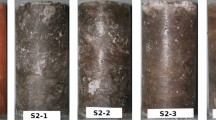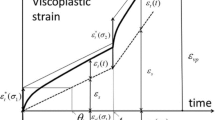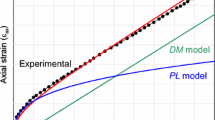Abstract
Actual problems in geotechnical design, e.g., of underground openings for radioactive waste repositories or high-pressure gas storages, require sophisticated constitutive models and consistent parameters for rock salt that facilitate reliable prognosis of stress-dependent deformation and associated damage. Predictions have to comprise the active mining phase with open excavations as well as the long-term development of the backfilled mine or repository. While convergence-induced damage occurs mostly in the vicinity of openings, the long-term behaviour of the backfilled system is dominated by the damage-free steady-state creep. However, because in experiments the time necessary to reach truly stationary creep rates can range from few days to years, depending mainly on temperature and stress, an innovative but simple creep testing approach is suggested to obtain more reliable results: A series of multi-step tests with loading and unloading cycles allows a more reliable estimate of stationary creep rate in a reasonable time. For modelling, we use the advanced strain-hardening approach of Günther–Salzer, which comprehensively describes all relevant deformation properties of rock salt such as creep and damage-induced rock failure within the scope of an unified creep ansatz. The capability of the combination of improved creep testing procedures and accompanied modelling is demonstrated by recalculating multi-step creep tests at different loading and temperature conditions. Thus reliable extrapolations relevant to in-situ creep rates (\(10^{-9}\) to \(10^{-13}\) s\(^{-1}\)) become possible.







Similar content being viewed by others
Notes
The effective stress is the norm of the stress deviator, \(\sigma _{\rm eff}=\sqrt{\frac{3}{2}{{\mathrm{tr}}}\,\sigma ^d \sigma ^d}\).
Abbreviations
- \(\epsilon _{\rm cr}\) :
-
Total creep deformation
- \(\epsilon _{\rm cr}^{\rm V}\) :
-
Hardening component of creep deformation
- \(\epsilon _{\rm cr}^{\rm E}\) :
-
Recovery component of creep deformation
- \(\epsilon _{\rm cr}^{\rm S}\) :
-
Damage-induced component of creep deformation
- \(\epsilon _0^{\rm V}\) :
-
Initial hardening
- \(A^{(p)}\), \(\beta\), \(\mu\) :
-
Primary creep parameters
- \(A^{(s)}_{1,2}\), \(Q_{1,2}\), \(n_{1,2}\) :
-
Secondary creep parameters (two-component power law)
- \(A_0\), \(h_0\) :
-
Initial sample cross section and height
- \(\Delta h\) :
-
Reduction in sample height
- \(\epsilon _{\rm ax}=\Delta h/h_0\) :
-
Axial strain
- \(\sigma _{\rm eff}\) :
-
Effective stress, \(\sigma _{\rm eff}=\sqrt{\frac{3}{2}{{\mathrm{tr}}}\,\sigma ^d \sigma ^d}\) with deviatoric stress \(\sigma ^d\)
- \(\sigma _1\), \(\sigma _3\) :
-
Major and minor principal stress
- \(\sigma _{\rm diff}\) :
-
Differential stress, \(\sigma _{\rm diff}=\sigma _1-\sigma _3\)
- T :
-
Temperature
- R :
-
Gas constant, \(R=0.00831\;{\rm kJ}/({\rm mol}\cdot{\rm K})\)
References
Bérest P, Béraud JF, Gharbi H, Brouard B, DeVries K (2014) A very slow creep test on an Avery Island salt sample. In: Proceedings of the 48th US Rock Mechanics Symposium (ARMA-14). American Rock Mechanics Association (ARMA), Minneapolis, 14–7052
Bérest P, Ghoreychi M, Hadj-Hassen F, Tijani M (eds) (2012) Mechanical behavior of salt VII. Taylor & Francis group, London
Blum W (1993) Plastic deformation and creep of crystalline materials. In: Mughrabi H (ed) Plastic deformation and fracture of materials, volume 6 of materials science and technology. VCH Verlagsgesellschaft, Weinheim, pp 359–405
Carter NL, Horseman ST, Russell JE, Handin J (1993) Rheology of rocksalt. J Struct Geol 15:1257–1271
Günther R-M, Salzer K (2012) Advanced strain-hardening approach: A powerful creep model for rock salt with dilatancy, strength and healing. In: Bérest P, Ghoreychi M, Hadj-Hassen F, Tijani M (eds) Proceedings of the 7th Conference on Mechanical Behavior of Salt, Paris, 16–19 April 2012. CRC Press/Balkema, Leiden, pp 13–22
Günther R-M, Salzer K, Popp T (2010) Advanced strain-hardening approach constitutive model for rock salt describing transient, stationary and accelerated creep and dilatancy. In: Proceedings of the 44th US Rock Mechanics Symposium (ARMA-10). American Rock Mechanics Association (ARMA), Salt Lake City/Utah
Hampel A, Argüello JG, Hansen FD, Günther RM, Salzer K, Minkley W, Lux K-H, Herchen K, Düsterloh U, Pudewills A, Yildirim S, Staudtmeister K, Rokahr R, Zapf D, Gährken A, Missal C, Stahlmann J (2013) Benchmark calculations of the thermo-mechanical behavior of rock salt—results from a US-German Joint Project. n: Proceedings of the 47th US Rock Mechanics Symposium (ARMA-13). American Rock Mechanics Association (ARMA), San Francisco
Hansen FD, Leigh CD (2011) Salt disposal of heat-generating nuclear waste. Sandia Report SAND 2011-0161, Sandia National Laboratories
Hunsche U, Schulze O, Walter F, Plischke I (2003) Thermomechanisches Verhalten von Salzgestein. Abschlussbericht Projekt Gorleben. Hannover: Bundesanstalt für Geowissenschaften und Rohstoffe (unpubl.)
Minkley W, Popp T (2010) Final disposal in rock salt–geomechanical assessment of the barrier integrity. In: Proceedings of the 44th US Rock Mechanics Symposium (ARMA-10). American Rock Mechanics Association (ARMA), Salt Lake City/Utah, pp 10–492
Odqvist FKG, Hult H (1962) Kriechfestigkeit metallischer Werkstoffe. Springer, Berlin
Salzer K (1993) Ableitung eines kombinierten Kriechgesetzes unter Berücksichtigung der Erholung. Teilbericht zum BMFT Vorhaben 02 C 00 628. Institut für Gebirgsmechanik, Leipzig (unpubl.)
Urai J L, Spiers CJ (2007) The effect of grain boundary water on deformation mechanisms and rheo-logy of rock salt during long-term deformation. In: Proc. 6th Conference on the Mechanical Behavior of Salt “Saltmech6” Hannover, pp 149–158
Urai JL, Spiers CJ, Peach CJ, Franssen RCMW, Liezenberg JL (1987) Deformation mechanisms operating in naturally deformed Halite rocks as deduced from microstructural investigations. Geol Mijnbouw 66:165–176
Acknowledgments
Financial support by the Federal Ministry of Education and Research (BMBF, projects I and II) and the Federal Ministry of Economics and Technology (BMWi, project III), and advisory support by the Project Management Agency Karlsruhe (PTKA-WTE) are gratefully acknowledged. We thank the partners in the “Comparison of Constitutive Models” for the joint projects “Thermo–Mechanical Behaviour of Rock Salt” for the long-lasting and fruitful cooperation.
Author information
Authors and Affiliations
Corresponding author
Rights and permissions
About this article
Cite this article
Günther, RM., Salzer, K., Popp, T. et al. Steady-State Creep of Rock Salt: Improved Approaches for Lab Determination and Modelling. Rock Mech Rock Eng 48, 2603–2613 (2015). https://doi.org/10.1007/s00603-015-0839-2
Received:
Accepted:
Published:
Issue Date:
DOI: https://doi.org/10.1007/s00603-015-0839-2




